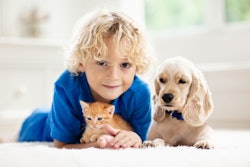
Both technology and necessity may to be converging to boost virtual reality’s use by dog, cat and other pet food companies. The pandemic impedes business travel, group meetings, trade events and other mainstays of the pet food industry. Meanwhile high-powered computers, specialized programming and other innovations make virtual reality a feasible option, especially for training and collaboration.
Nestlé Purina PetCare, the world’s second largest pet food company, conducted tours of their facility in Clinton, Iowa, USA using Oculus Business, owned by Facebook. Beyond pet food, Nestlé adopted virtual reality to set-up or redesign of factory lines, conduct maintenance work and check equipment with suppliers.
“It’s important for our associates to have an understanding of how we manufacture our products, and virtual reality is a great tool to help them do that, right from where they are based,” Gene Feldman, training manager for Purina, said in an email. “A few dozen associates have been able to virtually experience our factory in Clinton, Iowa, and we see great opportunities to expand this capability within the company and also potentially outside the company in the future. Now with more people being home-based, VR has gained additional support at Purina and within many industries.”
Virtual reality for pet food companies
Virtual reality technology may have two main uses in the pet food industry, a Facebook spokesperson said in an email.
“Broadly, training and collaboration are two of the biggest applications we see,” she said.
Training involves two components. The first is functional and involves learning or perfecting skills in otherwise hard-to-replicate scenarios. The second includes soft skills building empathy and conversational skills.
“Collaboration reaches across many experiences, but with VR, people can share spaces and accomplish tasks just like they might in the same room with software and virtual meeting rooms powered by companies like Spatial, Arthur Digital, Iris VR and Insite,” she said. “For instance, Nestlé Purina Petcare uses VR to enhance remote collaboration, improve retail planning, and break down barriers to collaboration with Oculus for Business. The company estimates it saved over US$100,000 on travel and lost productivity by training staff using VR and is planning to expand its VR program beyond training for other productivity gains. The sales team at Nestlé Purina Petcare also meets in VR to collaborate on projects and train associates using a suite of new dynamic tools.”
Virtual reality in pet food trade events
Augmented reality, 3D headsets and virtual reality have started to appear in booths at pet food trade shows, over the past few years. This year, virtual events were virtually the only events. While pet food events didn’t include immersive virtual reality experiences this year, they could in the future.
“In planning a successful trade show exhibit, you’re often challenged to make a lasting impression,” the Facebook spokesperson said. “The implementation of VR demos, tours, and tutorials can not only help engage potential customers, but also create emotional connections by telling a company’s story in an immersive, interactive way like never before.”


















